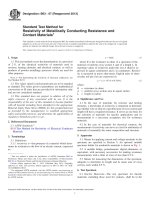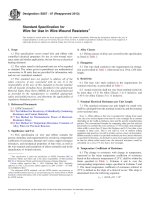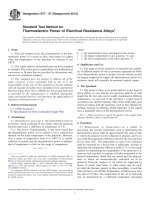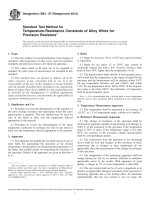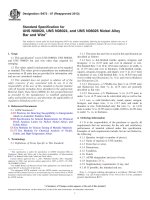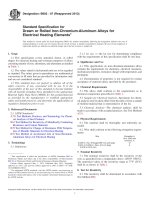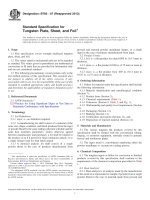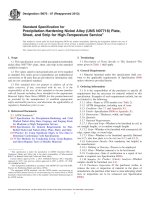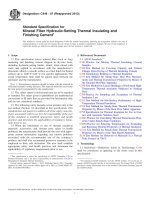Astm d 861 07 (2013)
Bạn đang xem bản rút gọn của tài liệu. Xem và tải ngay bản đầy đủ của tài liệu tại đây (52.45 KB, 2 trang )
Designation: D861 − 07 (Reapproved 2013)
Standard Practice for
Use of the Tex System to Designate Linear Density of
Fibers, Yarn Intermediates, and Yarns1
This standard is issued under the fixed designation D861; the number immediately following the designation indicates the year of
original adoption or, in the case of revision, the year of last revision. A number in parentheses indicates the year of last reapproval. A
superscript epsilon (´) indicates an editorial change since the last revision or reapproval.
This standard has been approved for use by agencies of the Department of Defense.
1. Scope
3. Terminology
1.1 This practice covers the use of the tex system to
designate the linear density (number, or count) of fibers and of
yarns made from any type of fiber or combination of fibers. It
is also applicable to other textile materials, including yarn
intermediates (slivers, rovings, tops, etc.), single or plied yarns,
cords, and threads.
3.1 For all terminology relating to D13.58, Yarns and
Fibers, refer to Terminology D4849.
3.1.1 The following terms are relevant to this standard:
linear density, tex.
3.2 For all other terminology relating to textiles, see Terminology D123.
NOTE 1—The mass per unit length concept of linear density is
applicable to any material which has a high ratio of length to cross section.
4. Significance and Use
4.1 The tex system has been approved for general use by the
International Organization for Standardization, Technical
Committee 38 on Textiles (ISO/TC 38), which has also
recommended a list of rounded tex numbers for use with fibers
and all types of yarns. Conversion tables showing the rounded
tex numbers corresponding to various numbers in different
traditional systems are given in Tables D2260 and ISO 2947.
1.2 Conversion factors for various indirect and direct yarn
numbers to exact tex equivalents can be found in Standard
Tables D2260.
1.3 This standard does not purport to address all of the
safety concerns, if any, associated with its use. It is the
responsibility of the user of this standard to establish appropriate safety and health practices and determine the applicability of regulatory limitations prior to use.
4.2 The tex system for designation of the linear density of
fibers and yarns is a direct system based on mass per unit
length, M/L, and employs metric units of length and mass. The
tex unit, grams per kilometre (1000 m) has been approved by
ISO/TC 38 for use with all fibers and all types of yarn. The
committee has also approved the use of kilotex and decatex
numbers for coarse structures and decitex and millitex numbers
for fibers.
2. Referenced Documents
2.1 ASTM Standards:2
D123 Terminology Relating to Textiles
D2260 Tables of Conversion Factors and Equivalent Yarn
Numbers Measured in Various Numbering Systems
D4849 Terminology Related to Yarns and Fibers
4.3 The tex system relates to the property commonly associated with coarseness, or inverse fineness of a yarn because
the tex numbers increase with an increase in the size or mass
per unit length of the yarn. The tex system is intended for use
by all branches of the textile industry, in all countries, for yarns
made from all types of fibers or mixtures of fibers.
2.2 ISO Standards:
ISO 2947 Textiles—Integrated Conversion Table for Replacing Traditional Yarn Numbers by Rounded Values in the
Tex System3
1
This practice is under the jurisdiction of ASTM Committee D13 on Textiles and
is the direct responsibility of Subcommittee D13.58 on Yarns and Fibers.
Current edition approved July 1, 2013. Published September 2013. Originally
approved in 1945 T. Last previous edition approved in 2007 as D861 – 07. DOI:
10.1520/D0861-07R13.
2
For referenced ASTM standards, visit the ASTM website, www.astm.org, or
contact ASTM Customer Service at For Annual Book of ASTM
Standards volume information, refer to the standard’s Document Summary page on
the ASTM website.
3
Available from the American National Standards Institute, 11 West 42nd Street,
13th Floor, New York, NY 10036.
5. Recommended Applications
5.1 It is recommended that tex units, including their multiples and submultiples, be used to designate the linear density
of all natural and man-made fibers, filaments, yarns, cords,
rovings, tops, etc.
5.2 It is recommended that linear density be reported to
three significant figures, using either millitex, decitex, or tex
units.
Copyright © ASTM International, 100 Barr Harbor Drive, PO Box C700, West Conshohocken, PA 19428-2959. United States
1
D861 − 07 (2013)
5.3 It is recommended that linear density be expressed in
dicitex or tex units and reported to three significant figures, and
that kilotex units be used for all numbers above 999.9 tex.
NOTE 2—In calculating breaking tenacity, the values for the average
breaking force and the average linear density used in the calculations
should retain two more significant figures than the single observed values.
5.4 It is recommended that the breaking tenacity or tenacity
at any specified elongation for individual fibers, filaments, or
yarns be expressed in newtons (decinewtons, centinewtons, or
millinewtons) per tex.
6. Keywords
6.1 linear density; tex; tex system; textile fibers; textile
strand; yarn; yarn intermediates; yarn number
ASTM International takes no position respecting the validity of any patent rights asserted in connection with any item mentioned
in this standard. Users of this standard are expressly advised that determination of the validity of any such patent rights, and the risk
of infringement of such rights, are entirely their own responsibility.
This standard is subject to revision at any time by the responsible technical committee and must be reviewed every five years and
if not revised, either reapproved or withdrawn. Your comments are invited either for revision of this standard or for additional standards
and should be addressed to ASTM International Headquarters. Your comments will receive careful consideration at a meeting of the
responsible technical committee, which you may attend. If you feel that your comments have not received a fair hearing you should
make your views known to the ASTM Committee on Standards, at the address shown below.
This standard is copyrighted by ASTM International, 100 Barr Harbor Drive, PO Box C700, West Conshohocken, PA 19428-2959,
United States. Individual reprints (single or multiple copies) of this standard may be obtained by contacting ASTM at the above
address or at 610-832-9585 (phone), 610-832-9555 (fax), or (e-mail); or through the ASTM website
(www.astm.org). Permission rights to photocopy the standard may also be secured from the ASTM website (www.astm.org/
COPYRIGHT/).
2

